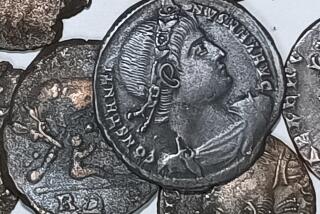A Rich Collection Illustrates History of Money
- Share via
LONDON — In Mesopotamia 4,500 years ago, a father put a price on his daughter: he sold her into slavery for 2.5 shekels, or 21 grams of silver, about $3.67 at today’s prices.
The record of that transaction, scratched on a clay tablet, is one of the more unusual of the 3,000 exhibits in the new Money Gallery at the British Museum.
“That was what she was worth--shocking to us but not extraordinary at the time. I think the people of those days would be shocked by our labor costs,” said Robert Anderson, director of the British Museum.
Money--or the love of it--has been called the root of all evil, but it makes the world work. As the new exhibit shows, it comes in all shapes and sizes, from shells to copper plates as well as coins, bank notes and even eggs in 19th century Guatemala. The Incas in South America valued shells more than gold.
“It is the first such gallery in a general museum anywhere and we could do it because we believe we have the finest collection of money in the world,” Anderson said before the gallery opened Jan. 31.
A book about the gallery opens with a Flemish painting of 1514 showing a moneylender and his wife counting and weighing coins. Next to it is a shot from the Hollywood movie “Gold Diggers of 1933” featuring a chorus line singing “We’re in the money” while wearing costumes decorated with silver dollars.
The gallery display runs from the first use of weighed silver and other metals in antiquity to a 1901 cash register to an an electronic terminal manufactured last year to make payments with debit cards.
“The museum had coins from the start when it was founded in 1753 . . . and it has been collecting money ever since. We now have the finest collection of money in the world, nearly 1 million items,” said Joe Cribb, the gallery’s curator.
Among the fascinating items is a list of expenses written on wood by a 2nd century Roman legionary and found preserved in wet ground at Hadrian’s Wall in northern England.
Andy Meadows, a curator of antique coins, said a list of finances for maintaining a fort at the wall show what commodities cost during the Roman occupation: a bronze coin called an “as” would buy 50 hobnails.
The as and the silver denarius were the two principal Roman coins following a currency reform in 212 BC.
“We do know that there wasn’t a Roman coin small enough to buy a pint of beer. What did they do? Probably bought a round,” Meadows said.
There are bright and gleaming gold bars from ancient Rome and Egypt--gold doesn’t tarnish even when buried.
There is paper money invented in China in the 11th century and which degenerated into mind-boggling sums in 20th century inflation: a 1923 German bank note with face value of 1 billion marks and a 1946 Hungarian note of 100,000 billion pengoes.
Europe’s first banknotes originated in 17th century Sweden when Johan Palmstruch, a banker, suggested using pieces of paper for money in place of sheets of copper, which weighed up to 44 pounds.
The sheets had been introduced to help maintain the price of Swedish copper but they were heavy to carry and were depreciating in value.
There are children’s money boxes and a leather bag of coins given to the museum by the Court of Chancery, which had held the money for 250 years in an unresolved legal case called Jones vs. Lloyd.
Why Jones sued Lloyd is no longer known. The four gold and 1,746 silver coins dated from the last quarter of the 17th century had a face value of about $375 then, and are worth thousands of dollars today. Several of the coins, however, were counterfeit.
Quantities of old gold and silver coins dug up in England are in the gallery after being declared treasure trove and therefore state property.
One such hoard found by a man in a field at Didcot, 50 miles northwest of London, contained 126 Roman aurei, the principal gold denomination of the empire.
“It was buried in a pot about 180 AD at the end of the reign of Marcus Aurelius. As one coin was equal to a month’s pay it must have been a legionary’s savings for 10 1/2 years,” Meadows said.
The money would be worth $224,000 today. “We’ll never know who he was, why he buried it and why he never went back to collect it,” Meadows said.
Entry to the gallery is free like the rest of the museum.






